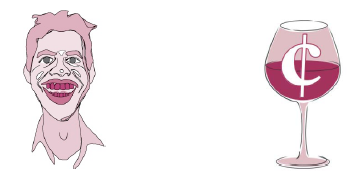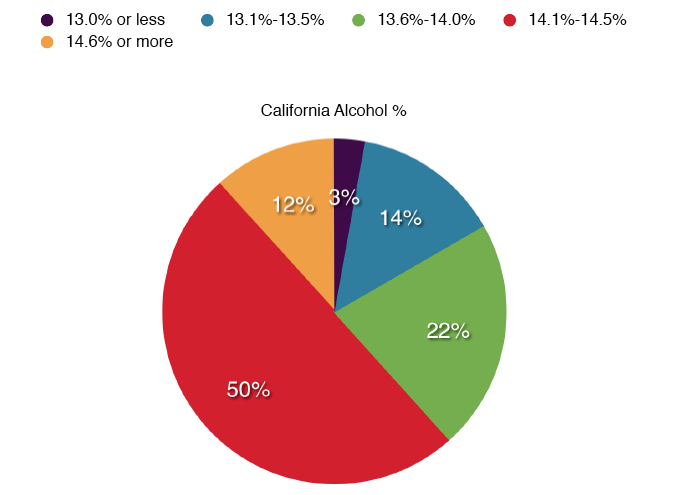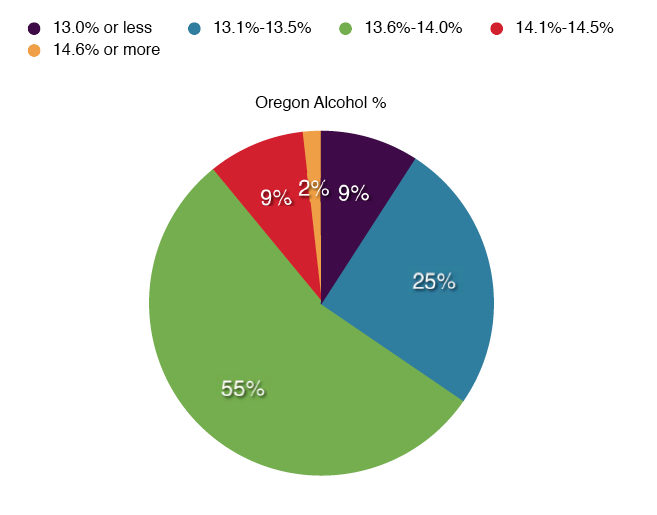2011 Pinot Noir All-Americans
It has become an annual tradition to name my favorite Pinot Noir performers at the end of the year. This issue
always stirs up the pot, for picking the best in any lineup of wines is always controversial.
There are a number of steps I take to arrive at the wines that I most recommend in the PinotFile each year and
then chose the best as All-Americans. The honored wines have all been tasted at my home in a quiet setting in
the late morning and over the course of a day or two. The wines come directly from my home cellar at about
63ºF and are all tasted in identical Riedel Vinum Burgundy or Riedel Oregon Pinot Noir stemware. I usually
taste 6 to 8 wines a day, giving each wine adequate time to open up in the glass and I make several passes as
I taste each wine carefully. Occasionally I will decant a wine if the winemaker recommends it or if I think this
will benefit the evaluation.
I do not taste the wines blind, but strive for integrity, consistency and objectivity. I take my responsibility
seriously. There are three reasons that I do not taste blind. First, I prefer to evaluate wines in the same
manner as the consumer experiences them. Second, I believe an essential part of judging wine is to know
what you are drinking. Third, I often have all the production information of the wine at hand that assists me in
understanding the wine. The more background information I have, the more I am likely to discover in the wine.
As Jamie Goode has pointed out, "When we are tasting blind, there is a limit to what we can say about the wine that is in front of us."
I tend to focus on current drink ability, since most consumers prefer to drink their wines relatively young. I most
appreciate wines that are at or close to their best the days I taste them. That said, credence is given to age
ability particularly in the context of balance. I often re-taste wines later in the day with food at dinner to
replicate the consumer’s drinking experience, or the next day or two from an opened and re-corked (but not
gassed) bottle. The latter gives me insight into the quality, balance and age ability of the wine.
I do not award scores to wines, preferring to give an unpretentious, concise, and descriptive review to reveal
the style and quality of the wine that the reader can easily understand and appreciate. I am convinced that an
apropos description of a wine is not only more challenging to arrive at than awarding a score, but it is the fairest
way to evaluate a wine. The Pinot Geek icon is used to designate wines of exceptional merit and these wines
are the only ones considered for All-American honors. The Value icon is used to indicate wines of good or
better quality that are value priced (less than $35).

It is very challenging to single out wines from the vast array of stellar Pinot Noir currently being crafted in
California and Oregon. As wine maker Daniel Baron has said, “You have to remember this when you think
about judging wines. They’re alive and changing moment to moment; they have good days and bad; they show well in a particular glass or with particular food. Judging a wine at any particular moment in life is like giving a
kid a letter grade based on his behavior in the supermarket.”
Aromatics, flavor nuances, texture, balance, and finishing persistence all come in to play in finding those
special wines that stand out from the pack. Often it is not an objective feature, but the emotion that the wine
elicits that sets the wine apart. There are many technically sound wines today but All-Americans have a
powerful charisma. It is a truth that it is not what is said or written about a special wine, but what is emoted that
truly defines a wine’s greatness. Veronique Drouhin-Boss, the winemaker at Oregon’s Domaine Drouhin, has
said it best, “There are plenty of good wines in the world that give you pleasure. A great wine gives you
emotion.” Remington Norman, in his latest book, Grand Cru, notes, “The impact of great wine is as much
emotional as sensorial and, in any case, at the topmost level one runs out of distinctive superlatives.”
The All-Americans are judged on merit, independent of price, vintage and region of origin. I drink a fair
amount of red Burgundy, but leave the critical evaluation of these wines to others more dedicated to that
region. I also taste and review Chardonnay, Pinot Noir’s cool climate partner.
I have no monetary arrangement with any winegrower, winery, retailer or wholesaler. I do accept wines for
review but about a third of the wines I sample are bought directly from a winery or through customary retail
channels. There are many Pinot Noirs that I sample casually at wineries (including barrel samples), social
dinners, Pinot Noir festivals, competitive wine judging events, wine tastings and wine dinners, but I do not
include these wines in the All-American selection process. Only finished, bottled wines that are formally tasted
in controlled, and therefore comparable, circumstances are eligible for All-American consideration.
I attempt to separate my personal Pinot Noir stylistic preferences from the objective assessment of the wines.
The stylistic superiority of power versus finesse, “New World” versus “Old World,” and high alcohol versus low
alcohol continues to be debated, but the inimitability of either style will in the end be decided by the consumer.
The best style is the one that gives the drinker the most pleasure. I try to steer a neutral course and reward
wines for their excellence regardless of “style.” It boils down to distinguishing between appreciating and
liking. That said, I must admit preferring (liking) wines with under 14.2% alcohol since they are often more
balanced, easier to drink, more compatible with food, allow you to drink two or three glasses without getting
sideways, and confer the health benefits associated with taking in moderate amounts of alcohol.
Of the wines receiving All-American awards in this issue, nearly all the wines were from the 2008 and 2009
vintages. The California Pinot Noirs ranged in alcohol percentage from 12.3 to 15.5 with 50% of the wines
between 14.1 and 14.5 alcohol. In comparison, the Oregon Pinot Noirs ranged in alcohol percentage from 12.4
to 15.0 with 55% between 13.6 and 14.0 alcohol. The two charts below reflect this difference. Keep in mind that
the alcohol percentages are not always “honest,” but taken from labels or tech sheets. Since a 1% reporting
leeway is permissible with wines above 14.0% alcohol, the actual percentage in many cases is higher. It is
noteworthy that at least one prominent wine publication (Wine Enthusiast) and one wine competition (San
Francisco Chronicle Top 100 Wines of 2011) now report the alcohol percentage of their rated wines along with
case production and price. I believe I was the first published wine critic to include alcohol percentage in my
wine reviews, something I began doing in 2005.


I wish to emphasize that I do not take my reviews as gospel. I always keep in mind the tenant written by noted
New Zealand winemaker Neil McCallum, namely, “The difficult art of wine tasting requires a considerable
measure of humility.” I preach that you use my tasting notes as a guide, but trust your own palate. Focus
more on the producer than any one specific wine.
The awarded wines are listed in alphabetical order or from lowest to highest price in the case of value-priced
wines. Many of the wines are still available from the winery, through retail distribution or the secondary
marketplace. When possible, I will indicate a source for the wine. Even though some wines are offered only to
mailing list members, they may still be available and it is always worthwhile to make a phone inquiry. The
reality is that the economy has posed a challenge for wineries selling wines priced above $50. A few of the
most desirable wines are highly allocated, sold out, or only available through a reseller or auction marketplace.
The best free wine search engines are wine-searcher.com, vinquire.com, vinopedia.com, winezap.com and
wineaccess.com. If there is a Pinot Noir you just have to have and are unable to locate it, contact me and I will
try to track it down for you through my connections. Keep in mind, there will always be another vintage and top
producers make quality wine consistently in each vintage. The wine may not be the same song, but it will be
the same composer. Membership in winery wine clubs or participation in a winery’s mailing list are good ways
to insure that you obtain highly coveted Pinot Noirs from a popular producer.
Current prices of awarded North American Pinot Noirs featured in this issue span the range from $5.99 to
$100. Generally, quality of life with Pinot Noir begins at $20, but expect to pay at least twice this for many
special wines. The 115 California Pinot Noirs awarded the Pinot Geek designation in 2011 had a price range of
$28 to $100. The 35 Oregon Pinot Noirs receiving the Pinot Geek designation in 2011 ranged in price from $35
to $100. 16 wines from California and Oregon received both a Pinot Geek icon and Value icon designation
($15-$35). The California wines awarded the Value Icon ranged in price from $6 to $35 and the Oregon wines
receiving the Value icon had a price range of $18 to $35. The Chardonnays awarded the Golden Geek icon
ranged in price from $21 to $75. 2 California Chardonnays received both a Golden Geek icon and Value icon.
Collecting and drinking Pinot Noir can be a rich man’s game if only trophy wines are sought. There are a
number of cult level Pinot Noirs from California and Oregon that are priced at or above $100. Fortunately, there
are many satisfying Pinot Noirs on the market that are priced less than $35. The increasing role of negociants
in the production of inexpensive Pinot Noir has made these so called value-priced Pinot Noirs more available
than ever. The 2011 Value Pinot Noir All-Americans represent the best $35 and under North American Pinot
Noirs I sampled this year. Value Pinot Noirs do not match up in quality of fruit, aromatic sophistication, and
flavor nuances compared to the more expensive prestige bottlings. You get what you pay for.
I do not keep exact counts, but the number of corked wines is diminishing and is only about 1% of the wines I
sample. Another 5% of wines do not appear to be corked but are just not right. I had two problems this year
with corked wines I should make you aware of. In one case, I bought an older vintage of a wine from a retailer
and the wine was corked. The retailer did not have a replacement and would not refund my considerable
investment. When you buy older wines, you buy at your own risk. The other corked wine came from a major
east coast retailer (Sherry-Lehman) and was a recent vintage. I contacted the retailer by e-mail after detecting
the corked bottle, and as is often the case, the retailer wanted to pick up the bottle for verification before
sending a replacement bottle. Keep this in mind when you come across a corked wine. Fortunately, for
samples at least, I usually have two bottles and only report a review of the stellar bottle. I have not met with
any problems with screw cap closures, but these are rare in California and Oregon on premium bottlings.
Today, the number of flawed commercial wines is extremely low.
You will notice that there are fewer Honorable Mention awards for Oregon Pinot Noirs compared to California
Pinot Noirs. That is simply because I am based in California, travel more often to California wine regions, and
taste about three times more California Pinot Noirs in an average year. This in no way represents a reflection
of relative quality of Pinot Noir between the two states.
There are a few awarded wines for which the reviews have not appeared in the PinotFile in 2011 but qualified
for All-American consideration. This is because the wines were tasted in December, 2011, but will not be
included in a newsletter write-up until 2012.
Some of your favorite producers may not be mentioned because I wasn’t able to taste the wines from every
California and Oregon winery that releases a Pinot Noir. For the Pinot Noirs that were left out of the awards this
year, the words of Mark Twain ring true, “It is better to deserve honors and not have them, than to have them
and not deserve them.”





